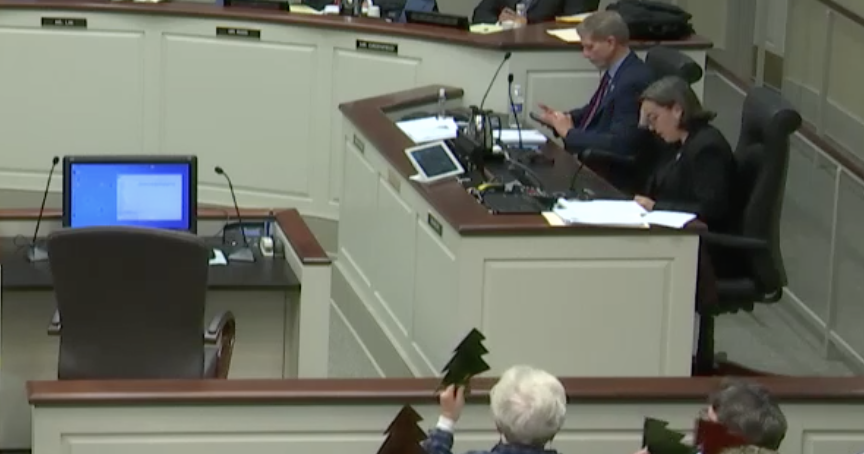
Local conservation groups joined residents of Fairfax’s Mosby Woods neighborhood in an Oct. 24 Fairfax City Council meeting to voice frustrations about an extension to the George Snyder Trail (GST).
The extension would cut through a portion of the urban forest in central Fairfax and construct a trail along Accotink Creek connecting Chain Bridge Road to Plantation Parkway and Route 50.
To affirm the city’s commitment to protecting its urban forests, Fairfax Mayor Catherine S. Reed began the meeting by calling up members of the city’s environmental sustainability committee to commemorate Oct. 29 as Arbor Day.
“Trees can be a solution to combating climate change by reducing the erosion of our precious topsoil by wind and water, cutting heating and cooling costs, moderating the temperature, cleaning the air, producing life-giving oxygen, and providing habitat for wildlife,” said Reed.
Despite this proclamation, some Fairfax residents feel this affirmation is inconsistent with the council’s interest in moving forward with constructing the GST through Mosby Woods.
“This present council has me very confused. You wanted to proclaim [Oct. 29] as Arbor Day, and yet some of you still support an expensive, poorly designed trail which would do the maximum damage to our environment,” said Fairfax resident Maryanna Fournier.
At the meeting, the Audubon Society of Northern Virginia handed out copies of an analysis detailing the destruction of trees needed to build the extension and strongly advised council members to reconsider its location.
“The project will destroy hundreds of trees. Where they are not cut down, tree roots will be cut, destabilizing the trees and compromising their ability to survive,” said Audubon Society Advocacy Committee Chair Tom Blackburn.
Conservation groups are also concerned about the trail’s impact on natural soil and say it would affect the forest’s health even where trees are preserved.
“To create a slope between the trail and the terrain on either side, more fill dirt will have to be added, or more soil will have to be excavated in a swath 20 to 50 feet wide perpendicular to that trail. Where fill dirt is added, it will cover the root flare, causing the tree to either suffocate or succumb to rot,” said Blackburn.
When speaking about the Audubon Society’s analysis, Friends of Accotink Creek representative Philip Latessa echoed concerns about the trail’s impact on the surrounding soil and raised concerns about the high financial and environmental cost of the trail.
“Our hearts sink at reading in that analysis the Panama Canal-style cutting, filling, and clearing needed to make this trail fit into the unsuited terrain,” said Latessa. “The cost is too high in setbacks to other important city goals: tree canopy, stormwater control, and climate change. All of them negatively impacted by the sacrifice of riparian forest.”
While they share concerns about the trail’s impact on the forest, Mosby Woods residents feel this project would further open their neighborhood to the bustling intersection of Chain Bridge Road and Route 50.
“It opens up the front of our neighborhood further to Eaton Place and Fairfax Boulevard, resulting in an eyesore where once trees stood, allowing residents to stare out at hardtop and buildings while listening to more traffic pass,” said Mosby Woods resident Clark Adams. “The noise pollution impact on the front of our community will be overwhelming.”
Additionally, many Mosby Woods residents expressed concerns about growing crime in their neighborhood and feel opening their backyards to this trail could only worsen the problem.
“We’ve witnessed a disturbing transformation to the George Snyder Trail. While these trails used to be primarily traveled by families, bikers, and walkers, now they’ve become the thoroughfare by which a large number of people experiencing homelessness and mental illness make their way from locations along Fairfax Boulevard,” said Adams.
“It is impossible to ignore the recent changes in and directly around our community,” said Mosby Woods resident Ashley Taylor. “I personally feel on edge and less safe, particularly when I walk through the trail and park at Draper Drive when I see adults openly drinking alcohol and loitering at Stafford Park during the day. The crime is already at our front door. Please don’t put it at our back door also.”
Following public comment, some council members shared diverging opinions on the adoption of an amendment to the city code, which allows for the construction of the trail.
“I think we’ve been ignoring residents for too long on this,” said Councilmember Kate G. Doyle Feingold, who voted against the motion. “Nobody who’s spoken out against it is against trails or connectivity. There are great alternatives that have been proposed. It’s time for us to step back, listen to residents, and come up with alternatives that satisfy the need for connection along with preserving our environment.”
“I disagree that we have ignored citizen input,” said Councilmember D. Thomas Ross, who voted in favor of the amendment. “The Snyder Trail is not a Mosby Woods project, with all due regard for those of you from Mosby Woods. It’s a city-wide project. It’s been developed with strong, ongoing community support. It’s been in several plans through the years.”
After deliberation, the motion passed with a council vote of 4 in favor and 2 opposed.